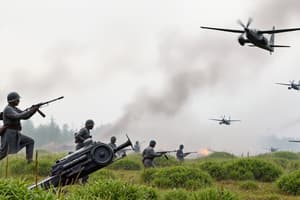Podcast
Questions and Answers
What are some key characteristics of totalitarian governments?
What are some key characteristics of totalitarian governments?
Totalitarian governments are characterized by control, suppression of dissent, and the concentration of power in the hands of a single leader or party.
Who is Adolf Hitler and what is the significance of Mein Kampf?
Who is Adolf Hitler and what is the significance of Mein Kampf?
Adolf Hitler was the leader of Nazi Germany. Mein Kampf is his autobiography, which outlines his Nazi ideology and plans for Germany's future.
What does the acronym MINT stand for, and what does it represent?
What does the acronym MINT stand for, and what does it represent?
- Management, Innovation, Networking, and Technology
- Military Intelligence, Naval Tactics, and Troop Movements
- Militarism, Imperialism, Nationalism, and Totalitarianism (correct)
- Money, Industry, Natural Resources, and Technology
What is meant by the term 'appeasement' in relation to World War II?
What is meant by the term 'appeasement' in relation to World War II?
What was the Lend-Lease Act, and why was it significant?
What was the Lend-Lease Act, and why was it significant?
What was the Atlantic Charter, and what were its main principles?
What was the Atlantic Charter, and what were its main principles?
Describe the events leading up to the Pearl Harbor attack and the resulting US actions.
Describe the events leading up to the Pearl Harbor attack and the resulting US actions.
What was the significance of the 'Home Front' during World War II?
What was the significance of the 'Home Front' during World War II?
What was the Office of War Mobilization and what were 'Cost-plus contracts'?
What was the Office of War Mobilization and what were 'Cost-plus contracts'?
Who was Rosie the Riveter and what did she symbolize?
Who was Rosie the Riveter and what did she symbolize?
What was the purpose of rationing and coupon books during the war?
What was the purpose of rationing and coupon books during the war?
Explain Executive Order 9066 and the Korematsu vs. US Supreme Court case.
Explain Executive Order 9066 and the Korematsu vs. US Supreme Court case.
What was the 'Bracero Program', and how did it relate to the war?
What was the 'Bracero Program', and how did it relate to the war?
What were Zoot Suit Riots and the Navajo Code Talkers, and how were they connected to the war?
What were Zoot Suit Riots and the Navajo Code Talkers, and how were they connected to the war?
What was the 'Double V Campaign', and what did it aim to achieve?
What was the 'Double V Campaign', and what did it aim to achieve?
What is 'blitzkrieg' and how was it employed in World War II?
What is 'blitzkrieg' and how was it employed in World War II?
What are some of the key turning points and events involving Hitler during World War II?
What are some of the key turning points and events involving Hitler during World War II?
What was the significance of sonar and convoys in World War II?
What was the significance of sonar and convoys in World War II?
Describe the Bataan Death March.
Describe the Bataan Death March.
What was the Battle of Midway, and why is it considered a major turning point?
What was the Battle of Midway, and why is it considered a major turning point?
What was the Invasion of Italy? Why was it important?
What was the Invasion of Italy? Why was it important?
Explain D-Day and why it was a monumental event?
Explain D-Day and why it was a monumental event?
What was the Battle of the Bulge, and what is its significance?
What was the Battle of the Bulge, and what is its significance?
What does V-E Day stand for and signify?
What does V-E Day stand for and signify?
Explain the role of kamikaze pilots and 'island topping' in the war.
Explain the role of kamikaze pilots and 'island topping' in the war.
Describe the significance of Iwo Jima and Okinawa in the Pacific Theater.
Describe the significance of Iwo Jima and Okinawa in the Pacific Theater.
What were some of the pros and cons of using atomic bombs during World War II?
What were some of the pros and cons of using atomic bombs during World War II?
What was the 'Manhattan Project'?
What was the 'Manhattan Project'?
What is the Holocaust?
What is the Holocaust?
Explain the division of Germany after World War II and the Yalta Conference.
Explain the division of Germany after World War II and the Yalta Conference.
Flashcards
Totalitarianism
Totalitarianism
A form of government characterized by extreme nationalism, centralized authority, and the suppression of opposition.
Mein Kampf
Mein Kampf
Hitler's autobiography and political manifesto, outlining his ideology and plans for Germany.
Militarism
Militarism
The aggressive foreign policy of a nation seeking to expand its power and influence through military force.
Imperialism
Imperialism
Signup and view all the flashcards
Nationalism
Nationalism
Signup and view all the flashcards
Totalitarianism
Totalitarianism
Signup and view all the flashcards
Appeasement
Appeasement
Signup and view all the flashcards
Neutrality
Neutrality
Signup and view all the flashcards
Lend-Lease Act
Lend-Lease Act
Signup and view all the flashcards
Atlantic Charter
Atlantic Charter
Signup and view all the flashcards
Pearl Harbor
Pearl Harbor
Signup and view all the flashcards
Embargo on Japan
Embargo on Japan
Signup and view all the flashcards
Home Front
Home Front
Signup and view all the flashcards
Office of War Mobilization
Office of War Mobilization
Signup and view all the flashcards
Rosie the Riveter
Rosie the Riveter
Signup and view all the flashcards
Rationing
Rationing
Signup and view all the flashcards
Executive Order 9066
Executive Order 9066
Signup and view all the flashcards
Korematsu vs. US
Korematsu vs. US
Signup and view all the flashcards
Bracero Program
Bracero Program
Signup and view all the flashcards
Double V Campaign
Double V Campaign
Signup and view all the flashcards
Study Notes
World War II Key Events and Concepts
- Totalitarian Control: A key aspect of the war, exemplified by Hitler's regime.
- Mein Kampf: Hitler's influential book.
- Militarism, Imperialism, Nationalism, and Totalitarianism (MINT): Concepts central to understanding the war's origins and conduct.
- Appeasement: A foreign policy strategy.
- Neutrality: A policy of non-participation in war.
- Lend-Lease Act: A US policy allowing aid to Allied nations.
- Atlantic Charter: An agreement between Allied leaders.
- Pearl Harbor and Embargo: Prominent events leading to US entry into the war.
- Home Front: The domestic impact of the war.
- Office of War Mobilization, Cost-plus contracts: Government strategies managing resources during the war.
- Rosie the Riveter: A symbol of women's contribution to the war effort.
- Rationing, Coupon Books: Government measures to conserve resources.
- Executive Order 9066 and Korematsu vs. US: Government actions related to Japanese Americans during the war.
- Bracero Program, Zoot Suit Riots, Navajo Code Talkers: Significant aspects of the war's social and cultural impact.
- Double V campaign: A civil rights campaign during the war.
- Poland and Blitzkrieg: The role of Poland in the early stages of the war
- Strategic Significance of Poland and lightning war: The initial stages of World War II.
- Turning Point and Hitler's Defeat: Decisive battles and events changing the course of the war.
- Sonar and Convoys: Naval technologies and tactics.
- Bataan Death March: A significant event in the Pacific theater.
- Midway: A pivotal naval battle in the Pacific.
- Invasion of Italy: Military action.
- D-Day: A major Allied landing in Normandy.
- Battle of the Bulge: A significant European battle.
- Victory in Europe (V-E): The end of the European conflict.
- Kamikaze Pilots, Island Hopping: Important tactics used in the Pacific.
- Iwo Jima and Okinawa: Key Pacific battles.
- Atomic Bombs: Their use and consequential effects.
- Manhattan Project: The development of the atomic bomb.
- Holocaust: The mass murder of Jews by Nazi Germany.
- German Occupation Zones: Post-war division of Germany.
- Yalta Conference Agreement: A discussion of unconditional surrender.
Studying That Suits You
Use AI to generate personalized quizzes and flashcards to suit your learning preferences.




